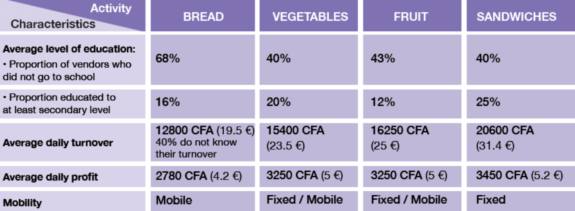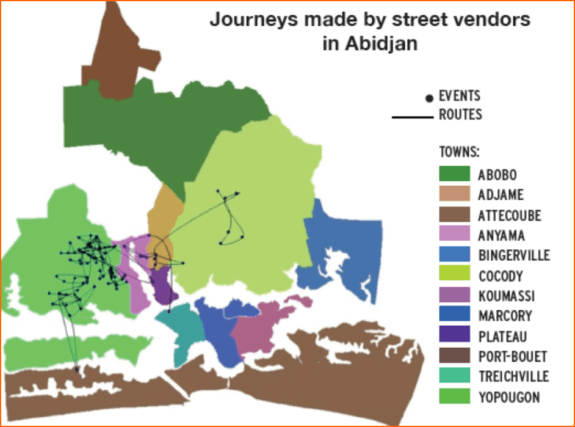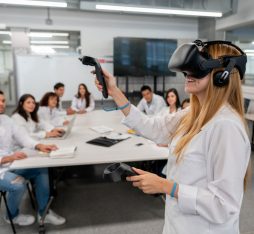The role of partnerships in supporting the informal sector
Launched in 2013 under the auspices of Bel Access, the Bel group’s social incubator, the Sharing Cities programme is part of this new approach. It aims to call on existing street vendor networks to sell La Vache Qui Rit cheese products in several big cities in emerging countries.
The idea of a partnership with Orange is to help meet the challenges of scaling up by capitalizing on technology. The aims are threefold: to keep down the cost of training street vendors by making use of technology for the first time; to optimize the monitoring and coordination of this new distribution network; and to use mobile technology to enrich the services offered through the social incentives policy (access to applications for children’s education, health insurance, access to financial services, discounted rates on calls and messages or on devices).
As the profit margins from selling portions of cheese do not provide the vendors with sufficient remuneration, the programme provides additional remuneration in the form of social incentives. In addition to training in skills specifically related to Bel products, as well as more general skills such as cold chain management, hygiene rules, and bookkeeping), the programme offers sickness insurance so that vendors can still fund their children’s schooling even if they fall ill. According to a study [2] conducted in the first two countries where the programme was rolled out (Vietnam and DRC), a 49% increase in vendors’ income was observed, justifying the public funding received by Bel as development aid.
By 2025, the aim is to extend the programme to 80,000 street vendors in around thirty cities worldwide.
What do we know about the street vendors?
The first country chosen for experimentation with the services developed as part of the partnership was Côte d’Ivoire. Almost everyone in employment there works in the informal sector (91.8%) and half the population lives below the poverty line [3]. Before the official launch, an exploratory survey (questionnaire completed by 70 female street vendors) and an analysis of the customer base and of call records for those vendors with an Orange SIM were carried out in 2015 and 2016.
Here, we report the initial results of a longitudinal monitoring protocol which uses qualitative and quantitative data (internal and external) to determine the vendors’ sociodemographic profiles, clarify their business activities and their expectations, and assess the appropriateness of the services offered and the relevance of the tools provided to Bel by Orange.
These vendors have the following characteristics: 97% are women; their average age is 38; 81% are Ivorian, 50% say they never went to school. This last figure is fairly similar to that found in the last household survey [3] in 2015, in which 49.3% of Ivorians said they had been to primary school, a proportion rising to 54.5% for women aged 35-39 living in Abidjan. The table below shows the average characteristics of vendors by business activity.

Source : Study conducted by J. Carcano for the Bel Access programme (2015)
Depending on their activity (selling bread, vegetables, fruit, sandwiches, etc.), their average daily profits vary from €4.20 to €5.20, which puts them above the poverty line. Bread sellers are the least likely to have attended school and also the group with the lowest average daily profit, suggesting a link between education level and revenue. Forty percent of them do not know their daily turnover. Bread selling also requires less complex skills than fruit and vegetable selling (stock management) or sandwich selling (turning raw materials into a finished product) and does not require a fixed stall, even a rudimentary one.
The average profit explains the higher-than-usual level of spending on mobile phone costs. The vendors spend FCFA 350 (€0.53) per day, which equates to 11% of their daily profit.
Most of this spending comes from using the voice function of their mobiles for personal purposes. All the street vendors own a mobile. 77% of respondents use their telephone for their work, but only 27% say it is essential for their business. Only 20% know how to send SMS and very few use the address book function (“I get my little book out to find the right number”). Only 7% of them have a smartphone, and few really know how to use all the features.
The survey also points out that 17% are already using a mobile payment solution, 77% have savings and 57% would be interested in using mobile banking solutions in the future.
The analysis of the location of street vendors could help the vendors negotiate with local authorities to obtain areas specially fitted out for their business. As well as a protected space, these entrepreneurs need services such as security, sanitation, electricity, transport and a water supply. These services are not provided by local authorities, with inefficient political decentralization and an ambiguous legal status depriving these informal businesses of the opportunity to participate in local governance [4]. Having an overview of the trading areas and the current infrastructure (or lack if it) in those areas could make it easier for public authorities to take account of vendors’ needs.
At this stage, the data have only highlighted the areas in which the vendors work and live, and their movements between these places (figure 1).

Figure 1: Geographical location of female street vendors based on call records of 3 February 2015
By analysing the social graphs, we can monitor changes in the street vendors’ dealings with one another over time and measure the effectiveness of actions designed to stimulate the community. The expected benefits are greater sharing of best practices and an ability for these collectives to negotiate better prices with their suppliers, assert their rights with the public authorities, and pool their savings.
We see very little interaction between vendors, however. The challenge for Bel’s community manager will therefore be to find levers for action in order to promote mutually beneficial cooperation.
Suitability of digital services for street vendor profiles and expectations
Pre-existing mobile usage patterns and related spending habits emphasize the fact that voice communication is the channel to be focused upon and that services connected to Orange Money could have strong potential.
Very few street vendors use SMS, most likely because they are not comfortable with the written word. Incorporating the functions offered by the M-Tew platform [7] in the training programmes provided by Bel could prove beneficial. The idea here is to capitalize on mobile learning experiments conducted with other targets in similar settings. As IFADEM shows for in-service training of primary school teachers in Madagascar [5], use of mobile technology and M-Tew services provides added value, targeting higher skill levels than training programmes that do not make use of such technology. The profile of street vendors is such that minimal use should be made of the written word for information messages, training assessments, FAQs and surveys.
The IFADEM Madagascar results also show that exchanges between peers boost knowledge acquisition. Analysis of street vendors’ spending on communications suggests that collaborative exchanges can be strengthened at minimal cost to the vendors themselves by encouraging these women to use the Orange Community offer. With this price plan, based on B2B offers, «intra-fleet» calls are free provided that monthly ARPU is greater than FCFA 3,000 – a level already exceeded by over 70% of vendors. Beneath that threshold, peer-to-peer calls are charged at a lower rate. Additional services have been added to this initial offer in order to attract and integrate vendors and keep them loyal so as to sustain a vibrant community beyond the initial training phase.
To this end, a number of promotional actions are to be trialled, such as sending cash via Orange Money, partial subsidization or free provision of smartphones, easier access to credit to support business development, and provision of educational applications for children.

uitability of digital services for street vendor profiles and expectations
Collective benefits of sharing cities hygiene training
It should be remembered that “hygiene interventions including hygiene education and promotion of handwashing can lead to a reduction of diarrhoeal cases by up to 45%.” [6].
An interview with the headteacher of one of the schools where vendors have set up their stalls and an analysis of the infirmary logbook show that cases of illness due to poor hygiene and resulting pupil absences have fallen dramatically following the application of the rules learnt as part of the programme. Not only do the “Mamas” apply these rules in order to improve the “upkeep” of their stalls; they also spread them among pupils (e.g. water basins have been provided for children to wash their hands before meals), establishing a virtuous cycle.
Conclusion
The preliminary results of the study show the potential benefits to a food manufacturer of supporting and developing the informal sector [8], as well as the effects on the productivity and disposable income of the programme’s beneficiaries. These expected effects and the indirect impacts stemming from improved hygiene justify the scaling-up of the initiative.
By tailoring the Orange services offered to match the profiles of the street vendors, we can pave the way for new usage practices, facilitating knowledge sharing through mobile technology (digital training, peer-to-peer sharing and coordination) within the communities we are seeking to develop.











